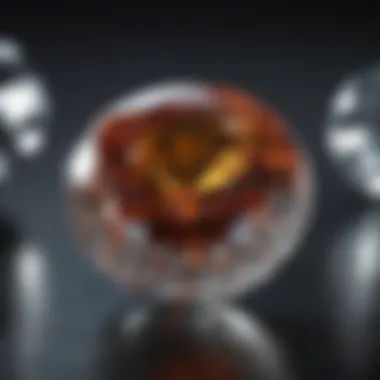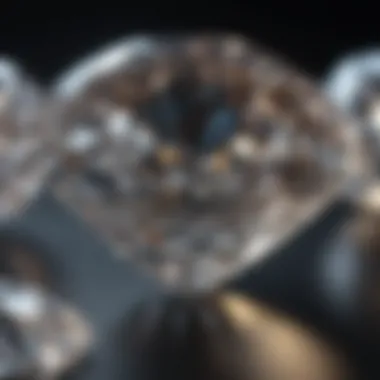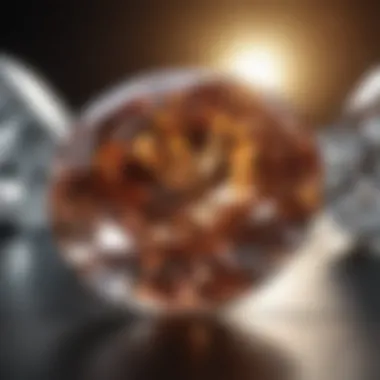Understanding Today's Diamond Valuation Trends


Intro
Understanding the complexities of diamond valuation is no small feat, especially in the ever-changing market landscape. For enthusiasts, collectors, and potential investors, demystifying the pricing of these precious stones becomes paramount. This article explores today’s trends surrounding diamond valuation, peeling back the layers of market demands, technological advancements, and unique valuation methodologies.
Engaging with diamond valuation involves knowing what constitutes value in the gem market. Factors such as rarity, demand, the beauty of individual stones, and emerging trends shape these valuations.
As the market fluctuates, keeping pace with these trends fosters informed decision-making, enhances investment strategies, and helps avoid common pitfalls. Whether you are an experienced collector or a newcomer looking to invest, having your ear close to the diamond industry's pulse can bring substantial rewards.
Gemstone Overview
Definition of Gemstones
Gemstones can be described as precious or semi-precious minerals, which are cut and polished into specific shapes for adornment. While diamonds are often the center of attention, other stones like rubies, sapphires, and emeralds also occupy significant spaces in the market. What truly defines these stones is their aesthetic appeal as well as their rarity.
Classification of Gemstones
When classifying gemstones, they can fall into several categories:
- Precious Stones: Includes diamonds, rubies, sapphires, and emeralds. These gems are often characterized by their hardness, rarity, and popularity.
- Semi-Precious Stones: Such as amethyst, citrine, and garnet, these stones are more abundant and can still be quite beautiful.
Understanding these classifications can provide insight into valuation dynamics and the levels at which diamond pricing operates.
Historical Significance
Origins of Gemstone Use
The fascination with gemstones dates back to ancient civilizations. Diamonds, for example, were once believed to hold magical properties and were worn by kings as a display of power and status. It is essential to examine how historical contexts and cultural practices can correspond with diamond price fluctuations today.
Cultural Insights: Gemstones in Ancient Civilizations
In ancient Egypt, gemstones were commonly used in burial rituals and as talismans believed to carry protective energies. The Greeks and Romans also had their favorites—diamonds, in particular, were seen as symbols of invincibility and divine favor.
These historical nuances not only enrich the narrative around diamonds but also inform current trends in valuation as cultures continue to value certain features over others.
"Gemstones carry stories from their origins to their current state, influencing their worth in the eyes of collectors and investors alike."
As we delve further into current trends, it becomes clear that understanding the past can provide invaluable insights for navigating the modern diamond market. The interplay between historical significance and contemporary valuation techniques will play a key role in our exploration.
Understanding the Diamond Market
The diamond market is an intricate web of factors that intertwine history, culture, and economics. A deep comprehension of this market is crucial for anyone venturing into the world of diamond valuation. This section uncovers the layers beneath the surface of diamond pricing, elucidating the historical context, and the influential factors that shape current rates. Understanding these elements will empower enthusiasts and investors alike to navigate the complexities of diamond investments successfully.
Historical Context of Diamond Pricing
To grasp the current landscape, one must first take a stroll through history. Diamonds have transitioned from rare gemstones primarily cherished by royalty to symbols of love and status for the masses. The price of diamonds has swayed over time, influenced significantly by extraction methods and marketing strategies.
In the early days, the value of diamonds was largely dependent on their rarity and the skill of the artisan. However, the De Beers Group established a firm grip on the market in the late 19th century, enforcing a paradigm where scarcity was artificially perpetuated. Their iconic "A diamond is forever" campaign popularized the concept of diamond engagement rings, in turn boosting demand. This historical manipulation of both supply and demand laid the groundwork for contemporary pricing mechanisms.
Factors Influencing Current Rates
Understanding current diamond prices entails examining several key factors. The intricate dance between supply and demand dynamics, cultural influences, and technological advances shapes the diamond valuation landscape.
Supply and Demand Dynamics
The fundamental principle of supply and demand acts as a cornerstone for diamond valuation. When more diamonds flood the market, prices tend to dip, whereas scarcities usually push values up. Presently, new diamond mines are relatively few, while older ones face depletion. This squeezed supply doesn’t just inflate prices; it also creates a perception of value due to decreasing availability.
The demand side showcases shifts in consumer preferences, particularly among younger generations who prioritize ethical sourcing and sustainability. For example, lab-grown diamonds have surged in popularity, challenging traditional mined diamonds, thereby affecting their value. Hence, the emerging balance or imbalance between these forces significantly contributes to the market's current state.


Cultural Influences on Value
Cultural factors also play a pivotal role in determining the valuation of diamonds. Societal perceptions can elevate or diminish the worth of diamonds overnight. For instance, in certain Asian cultures, diamonds are seen as prestige symbols, increasing their desirability and bidding up prices. Conversely, in regions where alternative gemstones resonate more with cultural values, traditional diamond valuation sees downward pressure.
Each culture's unique relationship with diamonds can lead to varying demand, significantly impacting overall market trends. Understanding these cultural nuances provides invaluable insight into consumer behavior, guiding more informed investment choices.
Technological Advances in Extraction
The world of diamond extraction has witnessed revolutionary technological advancements in recent years. Innovations like automated mining equipment and enhanced geological scanning methods have increased efficiency and yield, allowing firms to discover and extract diamonds more effectively. The modernized operations not only reduce extraction costs but can also lead to more environmentally conscious practices.
However, these technological improvements come with mixed implications. While they can increase supply, there's a risk that oversaturation can diminish perceived value, especially if customers feel inundated by choices. Thus, balancing technological advancements with market perception is essential in maintaining stable pricing in the diamond market.
Current Diamond Valuation Models
In the realm of diamonds, understanding valuation models is paramount. It’s not merely about what shines the brightest; it’s about how the market perceives and prices those glittering stones. The valuation models provide structure and transparency within a rather complex and sometimes opaque market. They shed light on multiple factors that play into how diamonds are valued, serving both collectors and investors keen on making informed choices.
In essence, valuation models can be thought of as a roadmap, helping individuals navigate through intricate pricing structures and market fluctuations. These models incorporate historical data, current market trends, and various grading systems that highlight different characteristics of diamonds.
The Cs of Diamonds
When it comes to diamonds, the 4 Cs—Carat weight, Cut quality, Color grading, and Clarity assessment—stand as the pillars of valuation. Each 'C' serves its own role in forming the final price tag and has unique implications that every enthusiast or investor should grasp.
Carat Weight
Carat weight speaks directly to the size of the diamond, and as is known, bigger often means pricier. This measure is essential in understanding a diamond’s value. A higher carat weight typically correlates with enhanced price points, making it a prominent factor for buyers looking for that standout piece. Bigger stones are rarer and thus can fetch a premium price, emphasizing their desirability.
However, it’s crucial to not just assume bigger is better. A 2-carat diamond of poor cut and clarity might be less valuable than a 1-carat stone with exceptional qualities. So, while carat weight holds significant weight (pun intended), it must be considered alongside other factors.
Cut Quality
Cut quality can be seen as the artist’s touch on the diamond. A expertly cut stone reflects light beautifully and often elevates its desirability. The cut determines how light interacts with the diamond. A diamond with a high-grade cut can appear larger and more brilliant, regardless of its carat weight.
A key aspect to consider is that cut quality is not something merely quantified but rather assessed by experts using gradings from excellent to poor. This subjective measure plays a major role in identifying why some diamonds glisten like stars while others remain lackluster.
Color Grading
In the world of diamonds, the term "color" carries different connotations. Most diamonds exhibit a slight color range, from colorless to shades of yellow or brown. The scale for grading runs from D (colorless) to Z (light yellow).
The rarity of a colorless diamond drives its market appeal, granting it a high price point. But again, context matters. Rare colors like red or blue can dramatically skew value, highlighting the importance of analyzing each diamond’s attributes holistically.
Clarity Assessment
Clarity assessment speaks to the internal imperfections or 'inclusions' present within the diamond. A stone rated as flawless commands a higher price due to its rarity. Investors often seek diamonds that are rated VVS (Very Very Slightly Included) or better to ensure quality. Inclusions can affect the visual appeal and surprisingly even the brilliance of a diamond.
Clarity grading adds another layer to the valuation mix. Inherited imperfections might not deter some purchasers but could lead others to seek out stones with higher clarity rating. Thus, considering this factor is essential when discussing overall value.
Market Reports and Indexes
A rich understanding of the diamond market isn’t just built on the characteristics of the stones themselves; it also requires a good grasp of how current market reports and indexes operate. These tools serve as invaluable resources in tracking prices and trends.
Role of Industry Publications
Industry publications are crucial in forming an accurate picture of the diamond market landscape. They provide data, research, and insightful articles focused on market conditions, trends, and forecasts. Regular features often include hot topics like ethical sourcing, pricing fluctuations, and updates on celebrity purchases, drawing focus to evolving buyer interests.
These publications essentially act as the pulse of the market, giving readers access to expertise and statistical analysis that can shape smart purchasing decisions. The challenge remains to find genuine sources, as not all publications maintain the same level of credibility or depth.
Influence of Online Marketplaces


Online marketplaces have emerged as a disruptive force within the diamond economy. E-commerce platforms allow consumers to access a broad array of styles and pricing without the constraints of traditional retail. The sheer availability of diamonds online opens up a range of options previously unavailable.
However, these platforms come with their own set of complexities. There can be vast discrepancies in prices attributed to varying vendor reputations, lack of standardization in quality assessments, and different policies regarding returns or guarantees.
Each aspect provides a piece to the puzzle, from understanding the intrinsic qualities of the stones to analyzing market dynamics. Navigating through these waters equipped with this knowledge can lead to sound investments that don’t just glitter, but come with lasting value.
Analyzing Current Rates
Understanding current rates of diamonds is crucial for both potential investors and those who are simply passionate about gemstones. As the market is constantly shifting, keeping an eye on real-time pricing trends can empower buyers and sellers alike, ensuring they understand the value of their assets fully. Analyzing these rates not only reveals the monetary worth of diamonds but also sheds light on broader market trends, consumer preferences, and emerging threats or opportunities within the industry.
Real-Time Pricing Platforms
The rise of digital platforms has made accessing real-time pricing for diamonds not just easy but necessary. These platforms allow users to monitor the fluctuations in prices daily, offering insights that traditional methods could not. By consolidating information across various sellers and regions, they provide a comprehensive view of the market.
For instance, websites like RapNet or 1stdibs give you an up-to-date snapshot of market trends, facilitating informed decisions. They often have tools that enable users to analyze historical pricing data, helping to predict potential future trends. What’s more, they offer transparency that can be hard to find in a traditionally opaque industry.
Regional Variations in Pricing
In diamond valuation, understanding regional pricing variations is paramount. Prices may vary significantly from one country to another, influenced by local economics, customs, and supply chains.
Global Trends
When discussing global trends, one characteristic stands out: the impact of large international markets like the United States and China. Demand in these regions can drastically affect prices worldwide. For example, as consumer spending surges in China, an increase in demand might push global prices upward. This can be a boon for investors with an eye on international jewelry markets. However, reliance on global trends can also present risks; ongoing geopolitical unhappiness could suddenly affect availability or prices, leading to instability.
- Key Characteristics of Global Trends:
- Advantages and Disadvantages:
- Global economic health: Strong economies tend to boost diamond sales.
- Cultural significance: Some nations prize diamonds for their symbolism, which can elevate demand.
- Advantage: Potential for higher returns in expanding markets.
- Disadvantage: Vulnerability to economic shifts and crises.
Local Market Influences
Local market influences play an equally important role. Pricing at a local level is affected by exclusivity, competition, and local demand patterns. For instance, a bustling city like New York may see higher diamond prices compared to smaller towns due to higher rent and seller competition. Local culture also has its part; some regions may favor particular styles or types of diamonds, elevating certain stones over others locally.
- Key Characteristics of Local Market Influences:
- Advantages and Disadvantages:
- Regional preferences: Some markets favor colored diamonds over traditional clear ones.
- Accessibility: Local sellers may have limited stock, affecting pricing and availability.
- Advantage: Local insights can provide exceptional deals, especially from smaller jewelers.
- Disadvantage: Lack of transparency compared to major global platforms can lead to under- or over-valued diamonds.
In summary, understanding both real-time and regional influences is essential for anyone looking to navigate the complex waters of diamond valuation. Mastering these nuances can lead to more informed buying and selling decisions, ultimately contributing to a more robust investment strategy.
Investment Considerations
When it comes to understanding diamonds as an investment, it’s crucial to recognize that value doesn’t always translate to price tags alone. The world of diamonds encompasses emotional value, cultural significance, and undeniable economic principles. Investors are navigating a complex landscape where trends can either scuttle or skyrocket their investments, depending on their awareness of prevailing market conditions. Knowing the nuances of diamond valuation allows investors to make sound decisions, ensuring they’re not just throwing money in the dark.
Long-Term vs Short-Term Trends
Investors often debate the merits of long-term or short-term investment strategies. Long-term investments in diamonds might appeal to those who see precious gems as a stable asset class, akin to real estate or stocks. Historically, diamonds have shown resilience against market downturns, meaning that certain investors may benefit by holding onto quality stones over extended periods.
Conversely, those looking to capitalize on short-term fluctuations can find themselves in a fast-paced environment where trends shift like the wind. Often, seasonal buying patterns, such as the holiday rush or even engagement season, can create spikes in demand and price. This can mean substantial profit for those who time their purchases right. However, identifying these trends requires keen market analysis and often a bit of intuition.
Risks Associated with Diamond Investment
Investing in diamonds doesn’t come without risks; understanding them is a critical part of the process.
Market Fluctuations


Market fluctuations are one of the more unpredictable elements of any investment. In the diamond industry, prices can vary significantly due to factors like economic changes, consumer preferences, and advancements in technology. These fluctuations can create opportunities, but they can also lead to losses. For instance, during an economic downturn, luxury items like diamonds may see decreased demand, causing prices to drop.
- Key Characteristic: Market fluctuations can reflect broader economic health.
- Why It's Beneficial: Staying informed about these shifts can help investors make timely decisions that may enhance returns.
- Unique Feature: Unlike more liquid assets, the diamond market can be slower to react, allowing knowledgeable investors to exploit temporary inefficiencies.
Liquidity Challenges
Liquidity in the diamond market can be challenging. Selling a diamond, especially a sizable one, doesn't guarantee quick cash. Unlike stocks that can be sold almost instantly, diamonds often require a willing buyer who appreciates the unique qualities of the stone. This liquidity challenge emphasizes the need for a long-term perspective when investing. It’s the understanding that diamonds typically are not an asset you sell on a whim.
- Key Characteristic: The resale market for diamonds is often less active.
- Why It's Beneficial: This slower process encourages thoughtful buying and selling, creating a more stable environment when done right.
- Unique Feature: Some diamonds appreciate over time, meaning holding onto them can yield better returns than quick resales.
Investors must consider both the allure of potential gain and the inherent risks tied to diamond investment. It’s a balancing act that calls for a thorough understanding of not just the gemstones themselves, but the overarching market dynamics impacting their value.
Future Outlook for Diamonds
The future of diamonds is a hot topic, and rightly so. As the world evolves, so too do the tastes and expectations of consumers. Understanding these shifts is crucial for stakeholders in the diamond industry. This segment explores significant elements shaping the market, including consumer trends, technological advancements, and critical ethical considerations that can no longer be brushed aside.
Shifting Consumer Preferences
The demographic profile of diamond consumers is changing. Traditionally, diamonds have signified status and wealth. However, a younger generation is now entering the market, one that is much more conscious about environmental and social impacts. They are seeking authenticity and value beyond the stone itself.
Some notable trends include:
- Digital Presence: Younger consumers often research diamonds online, relying heavily on social media and influencer recommendations.
- Preference for Experiences: There's a growing desire for experiences over possessions. This shift has made personalized jewelry captivating as it brings unique stories to each piece.
- Diverse Uses: Diamonds are no longer just for engagement rings. Birthdays, anniversaries, or even self-gifting have become more common, indicating a broader acceptance of diamonds as expressive of personal milestones rather than just traditional markers of romantic interest.
The crux of it all is that brands need to adapt and communicate their values effectively to resonate with today's shoppers. Aiming for authenticity and ethical considerations can be a winning formula in catering to these changing preferences.
Environmental and Ethical Considerations
As discussions around climate change gain momentum, environmental sustainability has become a central concern in the diamond industry. Consumers are increasingly inclined to understand the "backstory" of their diamond purchases. This consciousness brings us to two vital areas: lab-grown diamonds and sustainable mining practices.
Lab-Grown Diamonds
Lab-grown diamonds are more than just a modern trend; they represent a significant shift in how diamonds are perceived.
- Key Characteristic: These diamonds have the same physical, chemical, and optical properties as natural diamonds. The main distinction is their origin—lab-grown diamonds are created in controlled environments, often within weeks, while natural diamonds take millions of years to form.
- Appeal: Many consumers find lab-grown diamonds appealing due to their lower price points—often 20-40% less than natural diamonds. The ethical implications associated with them, avoiding the scrutiny attached to traditional mining, further enhance their attractiveness.
- Challenges: On the flip side, there's an ongoing debate surrounding their resale value. While they may fetch a good price initially, their long-term value remains uncertain, potentially deterring some investors who are used to traditional diamond appreciation.
Sustainable Mining Practices
Sustainable mining practices focus on reducing the environmental impact of extracting diamonds. From utilizing cleaner technologies to ensuring fair labor practices, this approach aims to reshape the industry responsibly.
- Key Characteristic: Ethical sourcing and transparent supply chains are integral. Consumers want proof that their diamonds are not contributing to harm or exploitation.
- Benefits: Companies adopting these practices not only help protect the environment but often enjoy enhanced brand loyalty and trust from consumers. Public goodwill is an invaluable asset in today's market.
- Drawbacks: However, sustainable practices can come at a higher cost, potentially raising the prices of ethically sourced diamonds. This pricing may make them less accessible to some consumers compared to those sourced traditionally, creating a delicate balance for retailers.
Ultimately, the call for greater sustainability in diamond resourcing can’t be ignored. Stakeholders who prioritize these aspects will likely thrive in the long run as today’s consumers become more aware of their choices.
Finale
In this final section, it is essential to understand the overarching themes and insights about diamond valuation discussed throughout the article. The diamond market, as complex as it is captivating, has seen numerous developments that influence its pricing structures.
Summarizing Key Insights
Throughout the article, we've delved into various aspects that shape the modern landscape of diamond valuation:
- Market Dynamics: The ever-changing supply and demand plays a pivotal role in determining prices. A local diamond’s price can fluctuate dramatically based on its source, availability, and current consumer interest.
- Cultural Factors: Different societies place varying levels of importance on diamonds, shaping their perceived value. For instance, in some cultures, diamonds symbolize wealth and status, while others see them as mere aesthetic objects.
- Valuation Models: The 4 Cs—carat weight, cut quality, color grading, and clarity, remain the bedrock of diamond valuation. However, with advancements in technology and access to real-time pricing platforms, these factors now interact with global market trends more dynamically than ever before.
"Understanding the nuances of diamond valuation enables smarter investment decisions, aligning consumer desire with market realities."
Final Thoughts on Diamond Investments
Considering an investment in diamonds means weighing multiple factors that can shift over time. Diamond prices are not only driven by intrinsic qualities but also by external market forces such as:
- Market Fluctuations: Investors should be aware that the value of diamonds can experience significant changes, often in comparison with traditional investments like stocks or real estate.
- Liquidity Challenges: Unlike stocks or bonds, turning a diamond into cash may not be straightforward. The niche market for high-quality diamonds presents unique challenges, as finding the right buyer can take time.
In summary, the diamond market possesses particular traits that require conscientious observation and research. Knowledge is power here; being informed can drastically improve one's position in this luxurious yet intricate arena.



